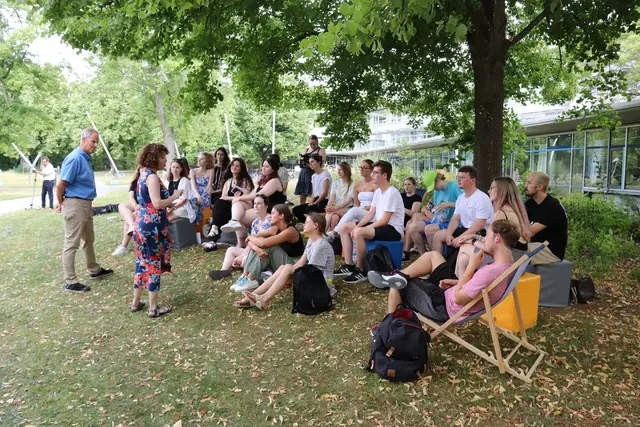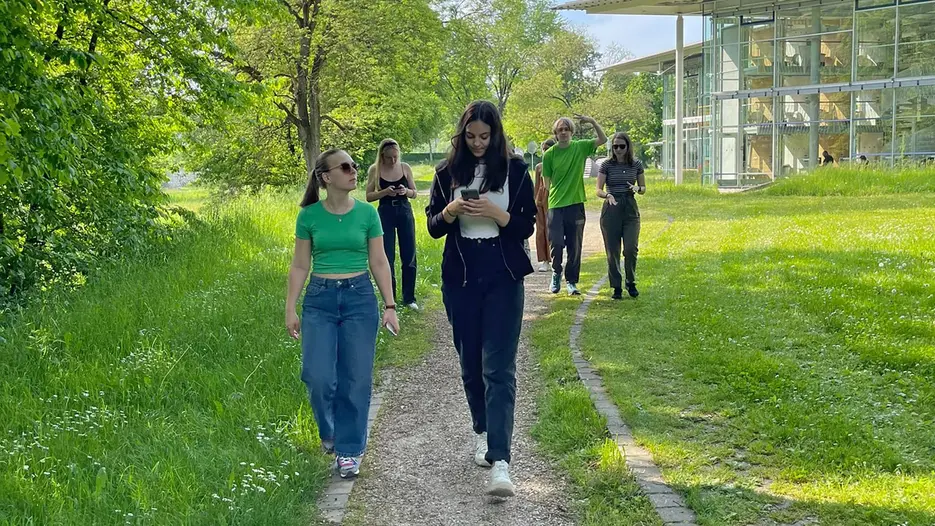Innovative open-air learning spaces: New Outdoor Campus at the KU

Amongst other things, the researchers used scientific findings from the field of neurosciences. Böttger explains: “Sensory learning is closely connected to the principle of a holistic approach. Under certain circumstances, sensory distractions outdoors, such as rustling leaves or the warmth of the sun, can have an additional positive effect on productivity. In outdoor didactics, selective hearing and vision guarantee more intensive intake, processing and memorization of what is taught, despite the many possible distractions.” Another plus of the open-air classroom is that it offers a counterbalance to sitting in lecture halls for long hours. Böttger continued to say that there was scientific evidence that content that was imparted while walking could be processed particularly well and memorized in the long-term and the informal atmosphere boosted creative processes and motivation.

For this purpose, the Outdoor Campus offers the “Walk’nTalk Trail”, a circular path leading around the Main Library. It can, for instance, be used for tasks that can be completed in partner work – ranging from brainstorming activities over discursive formats to students correcting each other’s pronunciation in conversations. This trail crosses with the “Riverside Taskway” that leads along the river Altmühl. Here, lecturers can divide teaching content up into small individual tasks or learning stations and structure it in a clear way. QR codes at the stations can be adapted and programmed to show interchangeable task formats that students can log onto using digital devices. A prerequisite for implementation of this format was Wi-Fi coverage that was newly installed in the area for this purpose. Another area of the Outdoor Campus called “Under the Trees” also offers flexible seating that can accommodate different group sizes who can discuss learning content there.

While the concept for the new campus space was designed in the language didactics department, those responsible explicitly also want to offer the learning space to other disciplines as well. Therefore, the Outdoor Campus website, that can also be accessed by scanning the QR code on the display board near the Main Library, lists a number of exemplary task formats that can inspire other lecturers. On the occasion of the festive opening ceremony of the new area, KU President Prof. Dr. Gabriele Gien emphasized that the Outdoor Campus provided “new impulses for all subject areas at the KU”. The fact that the project was designed as an offer for the entire University is a good foundation for the Outdoor Campus being anchored as a central scientific institution of the KU in the Center for Teacher Education (ZLB) after expiry of the initial pilot phase in the current summer semester. The ZLB has only recently opened the doors to its new premises that offer manifold possibilities for use reaching from purely digital courses to traditional classroom-format seminars. In general, the KU has the important goal of strategically developing its teaching practice further. This includes digitalization of university teaching that not only serves as an end in itself but also includes innovative formats contributing the character of a vivid Campus University. “Against this backdrop, the concept of an Outdoor Campus ideally complements the University’s endeavor to promote innovative teaching”, says Prof. Dr. Klaus Meier, Vice President for Studies and Teaching at the KU.
More information on the KU Outdoor Campus is available at www.ku.de/outdoor-campus.
